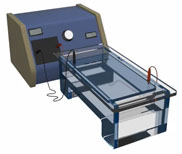
gel electrophoresis
Gel electrophoresis is a laboratory method used to separate mixtures of DNA, RNA, or proteins according to molecular size. In gel electrophoresis, the molecules to be separated are pushed by an electrical field through a gel that contains small pores. The molecules travel through the pores in the gel at a speed that is inversely related to their lengths. This means that a small DNA molecule will travel a greater distance through the gel than will a larger DNA molecule.
As previously mentioned, gel electrophoresis involves an electrical field; in particular, this field is applied such that one end of the gel has a positive charge and the other end has a negative charge. Because DNA and RNA are negatively charged molecules, they will be pulled toward the positively charged end of the gel. Proteins, however, are not negatively charged; thus, when researchers want to separate proteins using gel electrophoresis, they must first mix the proteins with a detergent called sodium dodecyl sulfate. This treatment makes the proteins unfold into a linear shape and coats them with a negative charge, which allows them to migrate toward the positive end of the gel and be separated. Finally, after the DNA, RNA, or protein molecules have been separated using gel electrophoresis, bands representing molecules of different sizes can be detected.
Further Exploration
Concept Links for further exploration
restriction mapping
|
RFLP
|
DNA
|
RNA
|
nucleic acid
|
amino acid
|
peptide
|
protein
|
Northern blot
|
Western blot
|
Southern blot
|
proteome
|
DNA sequencing

















